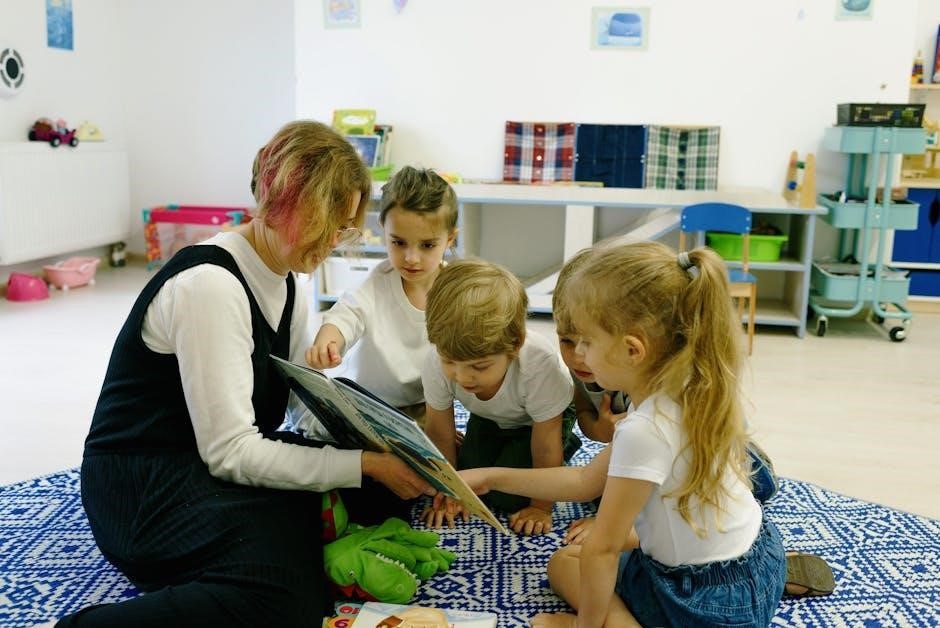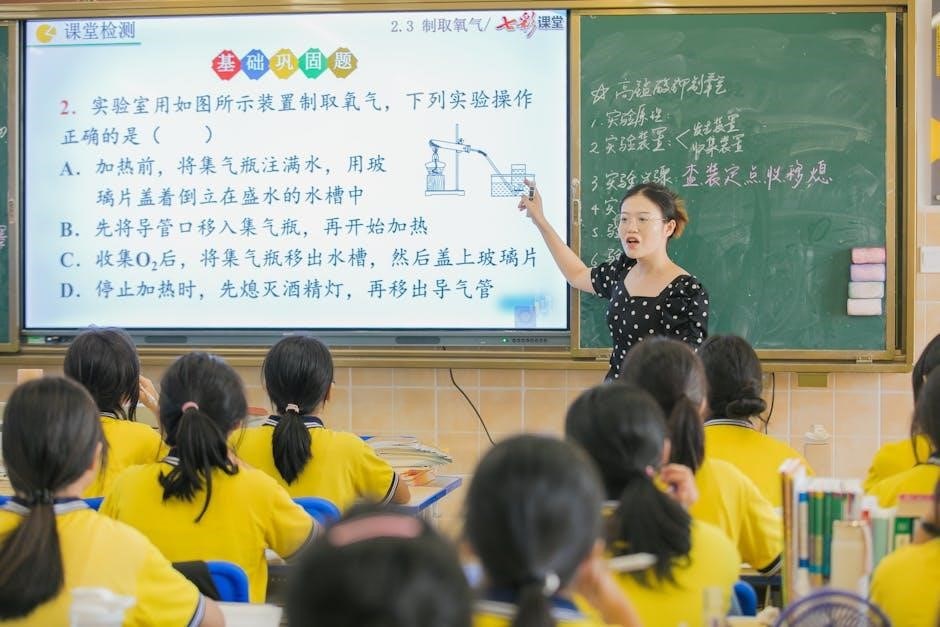Small group instruction in reading, guided by the Science of Reading, offers personalized learning opportunities. It allows educators to tailor teaching strategies to meet diverse student needs effectively, fostering improved literacy outcomes through targeted, evidence-based practices.
Defining the Science of Reading
The Science of Reading is an evidence-based approach to literacy instruction, focusing on how humans process written language. It emphasizes phonemic awareness, systematic phonics, fluency, and comprehension, grounded in cognitive and linguistic research. This framework prioritizes explicit teaching methods, ensuring all students develop the skills needed to read proficiently and access academic content effectively.
Understanding Small Group Instruction in Reading
Small group instruction in reading allows teachers to provide tailored support, addressing specific skill gaps and learning needs. It fosters active participation, enabling students to engage deeply with texts and strategies. This approach maximizes individualized attention, promoting accelerated progress and a stronger foundation in literacy skills through targeted, interactive lessons.

Key Principles of the Science of Reading
The Science of Reading emphasizes systematic phonics, phonemic awareness, and evidence-based instruction. It prioritizes decoding skills, vocabulary development, and comprehension strategies, ensuring all students master reading fundamentals effectively.
Systematic Phonics Instruction
Systematic phonics instruction is a cornerstone of the Science of Reading, teaching students to decode words by linking sounds to letters. It emphasizes explicit, sequential lessons on phonemic awareness, decoding, and encoding, enabling learners to read unfamiliar words confidently. This structured approach ensures all students, including struggling readers, build a strong foundation in reading, making it a critical component of effective literacy instruction.
The Role of Vocabulary in Reading Comprehension
Vocabulary knowledge is essential for reading comprehension, as it directly impacts a student’s ability to understand and interpret texts. Explicit instruction of high-frequency and domain-specific words, along with opportunities for application, enhances comprehension. Small group instruction allows teachers to model vocabulary use, provide context, and engage students in interactive activities, ensuring deeper understanding and retention of words critical to academic success and lifelong literacy.

Assessment and Data-Driven Small Group Instruction
Assessment identifies reading gaps, enabling targeted instruction. Data informs group formation and learning objectives, ensuring interventions are tailored to student needs for optimal progress and growth.
Using Assessments to Identify Reading Gaps
Assessments are crucial for pinpointing specific reading challenges. By analyzing results, educators can identify skill deficits, such as phonemic awareness or comprehension, and design targeted interventions. Regular evaluations ensure instruction aligns with student needs, fostering progress and preventing learning setbacks. Data-driven insights help create effective small group strategies, addressing gaps systematically for improved literacy outcomes.
Creating Targeted Learning Objectives for Small Groups
Targeted learning objectives are crafted using assessment data to address specific reading challenges. These objectives are clear, measurable, and aligned with individual student needs, ensuring focused instruction. By breaking down broader goals into manageable tasks, educators can tailor small group activities to build foundational skills and track progress effectively, fostering mastery and confidence in reading abilities.

Explicit Instruction in Small Group Settings
Explicit instruction involves clear explanations, modeling, and guided practice to build reading skills systematically. It ensures students understand concepts step-by-step, promoting active engagement and mastery in small groups.
Modeling Reading Strategies
Modeling reading strategies involves teachers explicitly demonstrating skills like comprehension, decoding, and fluency. Through think-aloud techniques, educators reveal their thought processes, helping students internalize these methods. Visual aids and gradual release of responsibility further enhance learning. This approach ensures students understand how to apply strategies independently, fostering confidence and proficiency in reading.
Guided and Independent Practice in Small Groups
Guided practice allows teachers to support students as they apply reading strategies, providing immediate feedback. Independent practice enables students to reinforce skills autonomously. This balanced approach ensures mastery, with small groups allowing for tailored instruction and fostering a collaborative learning environment that bridges guided support and self-directed application of reading skills.
Scaffolding Techniques for Small Group Instruction
Scaffolding provides temporary support to help students transition from teacher-led instruction to independent reading. It includes visual aids, modeling, and breaking tasks into manageable steps for better understanding.
Gradual Release of Responsibility
Gradual Release of Responsibility (GRR) is a scaffolding approach where teachers initially model reading strategies, then guide student practice with feedback, and finally allow independent application. This method ensures students build confidence and competence progressively, aligning with the Science of Reading principles to enhance literacy skills effectively in small group settings.
Using Visual Aids and Manipulatives
Visual aids and manipulatives, such as magnetic letters or phoneme cards, provide hands-on learning experiences. These tools help students visualize and interact with reading concepts, enhancing phonemic awareness and decoding skills. Interactive activities, like building words or sorting sounds, engage learners and reinforce teacher modeling, making abstract reading concepts tangible and accessible for small group instruction.

Differentiation in Small Group Instruction
Differentiation tailors reading instruction to meet varied learning needs, ensuring each student receives targeted support. It leverages diverse strategies to address individual abilities and promote equitable learning opportunities.
Addressing Diverse Learning Needs
Small group instruction allows educators to identify and cater to individual learning needs, ensuring all students receive tailored support. By incorporating evidence-based methods, teachers can address diverse abilities, learning styles, and challenges. This approach fosters an inclusive environment where every student can thrive, regardless of their unique requirements or skill levels. It emphasizes flexibility and adaptability in teaching strategies to meet the varied needs of learners effectively.
Integrating Multisensory Approaches
Integrating multisensory approaches enhances reading instruction by engaging students’ visual, auditory, and tactile learning pathways. Techniques such as using manipulatives, visual aids, and phonemic awareness activities help students connect sounds, symbols, and meanings. This method supports diverse learners, making complex concepts more accessible and fostering deeper understanding. Multisensory instruction aligns with the Science of Reading, promoting active participation and improved retention in small group settings.

Engagement and Motivation in Small Group Reading
Small group reading fosters engagement and motivation by allowing personalized interactions and tailored instruction. Students build confidence through active participation and meaningful discussions, enhancing their reading enthusiasm and progress.
Building Student Confidence
Building student confidence in small group reading involves creating a supportive environment where learners feel safe to take risks. Positive reinforcement, targeted feedback, and celebrating progress help students develop a growth mindset. Teachers foster confidence by providing opportunities for success, encouraging peer support, and ensuring each student feels valued and heard. This approach nurtures resilience and motivation, empowering students to embrace challenges and grow as readers.
Incorporating Collaborative Learning
Incorporating collaborative learning in small group reading fosters engagement and deeper comprehension. Students work together, sharing insights and strategies, which enhances critical thinking and communication skills. Peer discussions and shared reading tasks encourage active participation, while technology tools like Read Along in Classroom support collaborative practice. This approach not only strengthens reading abilities but also builds teamwork and mutual support, creating a dynamic and inclusive learning environment tailored to diverse needs.

Technology Integration in Small Group Reading Instruction
Technology enhances small group reading instruction by providing interactive digital tools and personalized learning opportunities, such as Read Along in Classroom, to support diverse learner needs effectively.
Digital Tools for Reading Practice
Digital tools, such as Read Along in Classroom, provide interactive reading experiences, enabling students to practice independently or in groups. These tools often include real-time feedback and progress tracking features, making them invaluable for personalized learning. They engage students with multimedia elements like audio support and interactive exercises, catering to diverse learning needs and fostering improved reading fluency and comprehension skills in small group settings.
Using EdTech for Personalized Learning
EdTech tools facilitate personalized learning by adapting to individual student needs, offering tailored reading experiences. These platforms use data to adjust difficulty levels and content, ensuring each learner receives relevant material. Multimedia elements, like videos and interactive exercises, enhance engagement. Teachers gain insights into student progress, enabling targeted support. This approach ensures effective, data-driven instruction, making learning more accessible and impactful for all students in small group settings.

Monitoring Progress and Adjusting Instruction
Regular formative assessments and data analysis enable teachers to track student progress and adjust instruction. This ensures tailored support, addressing specific needs and fostering continuous improvement in reading skills.
Formative Assessments in Small Groups
Formative assessments in small groups provide teachers with real-time insights into student progress. These brief, informal evaluations help identify reading gaps, allowing for immediate adjustments to instruction. Tools like exit tickets, reading checks, and observation notes enable targeted feedback. By regularly monitoring comprehension, fluency, and phonics skills, educators can refine lessons to meet individual needs, ensuring no student falls behind. This data-driven approach supports personalized learning and fosters academic growth effectively.
Reflecting on Instructional Effectiveness
Reflecting on instructional effectiveness involves analyzing teaching strategies and their impact on student learning. Teachers assess lesson outcomes, student engagement, and progress data to refine their methods. This reflection helps identify strengths and areas for improvement, ensuring instruction aligns with student needs. By evaluating what works and what doesn’t, educators can adjust their approaches, enhancing the overall quality of small group reading instruction and fostering better learning outcomes for all students.

Parent and Teacher Collaboration
Parent-teacher collaboration strengthens reading development by aligning home and school efforts. Open communication ensures consistent support, fostering a partnership that enhances students’ literacy growth and overall academic success.
Communicating Student Progress
Regular communication between parents and teachers is vital for tracking student progress in reading. Sharing updates on strengths, challenges, and growth ensures alignment in supporting each child’s literacy journey. Open dialogue helps parents understand their role in reinforcing reading skills at home, fostering a collaborative approach to education. Consistent updates also allow teachers to refine instruction based on individual student needs and progress.
Providing Resources for Home Practice
Equipping families with resources for home practice strengthens reading skills. Teachers can share phonics worksheets, digital reading apps, and guided reading materials. These tools help parents support learning consistently. Providing clear instructions and modeling activities ensures parents feel confident in assisting their children. Such collaboration bridges the gap between classroom and home, reinforcing literacy development and fostering a love for reading in a structured, supportive environment.
Case Studies and Success Stories
Real classroom implementations of the Science of Reading highlight transformative outcomes. Teachers share inspiring stories of improved literacy skills, showcasing effective small group instruction strategies and student progress.
Implementing Science of Reading in Real Classrooms
Educators have successfully applied the Science of Reading in diverse classrooms, demonstrating its effectiveness. One study highlighted a significant improvement in reading skills among students when systematic phonics and small group instruction were prioritized. Teachers reported enhanced engagement and comprehension, particularly for struggling readers. The approach emphasized explicit teaching, scaffolded learning, and data-driven adjustments, supported by professional development. These real-world applications underscore the transformative potential of evidence-based reading instruction.
Lessons Learned from Effective Small Group Instruction
Effective small group instruction emphasizes flexibility, differentiation, and teacher feedback. Educators have found success by tailoring lessons to students’ needs, using data to guide instruction, and fostering collaboration. Incorporating multisensory approaches and technology enhances engagement. Ongoing assessment and reflection ensure targeted support. These strategies highlight the importance of adaptability and student-centered teaching in maximizing reading growth and confidence.
